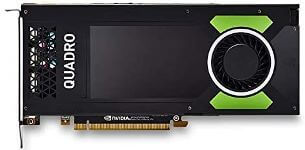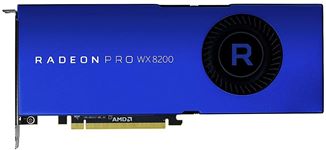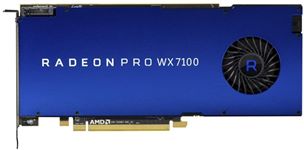Best Graphics Card For 3d Modeling
Picking a graphics card for 3D rendering and modeling is not an easy task; maybe not just that you have to select one with a specific amount of threads and cores, but it must also possess enough RAM.
It is necessary to have a reliable graphics card to work actively in a 3D scene. This is because the 3 d rendering process is an active one. As a result, one has to stay seated in front of their PC and provide continuous interaction.
An appropriate graphics card is vital to increase productivity and make you more proficient at using 3D software. Even the GPU market can be a complex thing, which is why we decided to put forward this post so that you can get an idea before purchasing the best graphics card for 3D rendering.
Also Check:-
- Best Graphics Card for AutoCAD
- Best Graphics Card Under $100
- Best Graphics Card For Under $150
- Best Graphics Card For 1080p 144hz
5 Best Graphics Card For 3D Rendering And Modeling | Top Picks
| 1. AMD Radeon Pro WX 8200 | |
| 2. PNY NVIDIA Quadro R TX 4000 | |
| 3. Asus ROG STRIX GeForce RTX 2080Ti | |
| 4. AMD Radeon Guru WX 7100 | |
| 5. PNY Nvidia Quadro P4000 |
I am always impressed by how AMD packs all these features into a very compact design and offers GPUs at such an economical price.
This Radeon Guru WX 8200 shipping with 3,584 cores. Tell me you will not notice a certain performance improvement in your manufacturing procedure. This GPU for sure works no matter the amount of detail, the rendering quality, or the opportunity to utilize your organization doing other tasks.
Interestingly enough, Radeon Guru WX 8200 uses the Vega architecture, the holy grail of all AMD workstation GPUs. When compared to this Quadro P4000, the WX 8200 comes out ahead of the competition. It features a boost clock rate of 1500MHZ but may have been read as 2000MHZ.
Radeon Pro WX 8200 offers 8GB of all HBM2 VRAM. This has even been a topic for debate among industry experts, but in my estimation, the decreased VRAM is likely to be the reason this GPU has been able to remain under $1000.
In spite of that, you will assume its price is too high, and soon you find out this GPU has error correction capabilities. You will rarely if ever, find a GPU at a price that enables such a feature.
A look at its power consumption will attest to its immense power. At 230 watts, it is the second-most energy-sipping GPU for the WX series. Its GPU consumes nearly as much as a Vega 6 quadrix. If you're trying to find a top-quality graphics card that provides high performance but shouldn't break the bank, the AMD Radeon Guru WX 8200 is an awesome choice.
2. PNY NVIDIA Quadro R TX 4000

- Professional application performance
- Latest NVIDIA Turing GPU architecture
- Ultra-fast graphics memory
- NVidia RTX technology
- 36 RT cores accelerate photorealistic
While the PNY Nvidia Quadro R TX 4000 may seem like it would be too expensive for many people, it provides great value for the dollar. Turing design quality assures real-time beam tracing is among its most distinguished features. It clocks in at a speed of 1005 MHZ; however, if you load it with a huge load to process, it can reach 1545 MHZ.
As well as being optimized for creative work, the Quadro 4000 will speed up the filters and plugins within applications like AutoCAD and Solidworks remarkably and speed up performance in areas like view and cartoon.
It provides more accurate antialiasing and wire-frame drops. The result is higher rates and more accurate renderings that are extremely close to reality.
One of the reasons you'll discover the Quadro R TX 4000 graphics card awesome is that it comes with a decent VRAM distance of 8GB to store files that are needed immediately. With the RT core, images and sound tones travel longer distances in 3D environments at speeds up to a Giga beam per minute.
This Quadro R TX 4000 provides performance typically associated with gaming GPUs, which directly contributes to the increased performance of your whole 3D surgeries.
The R TX's energy consumption is shockingly low at 160 watts. While this may seem like a substantial amount, it's a great deal when one considers its features and performance.
The GeForce R TX 2080 Ti supports up to 4K resolution as well. This GPU's biggest benefit, and the real selling point, is real-time beam tracing. Its only difference is the accuracy and effectiveness with which the graphics card uses the technology.
A graphics card with almost twice as much beam tracing hardware as this GPU enables users to delight in photorealistic light without enduring a ray tracing frame rate drop. The card also has twice the amount of graphics processing power.
Nvidia R TX 2080Ti offers a memory bandwidth of 616 GHz to ensure high-speed data transfer from GDDR6 VRAM into the GPU. This GPU clocks at 1635MHz, but can be overclocked further by users themselves.
Another interesting aspect is that despite the high processing power, the power consumption of the RTX 2080Ti is a little higher than the preceding cards.
The RTX 2080Ti GPU isn't you ideal solution whether you have a mid-sized workstation. You will need a state-of-the-art GPU that will fully utilize the processing power.
A great GPU from the WX show, the AMD Radeon Pro WX 7100, is ideal for simulation, visualization, and rendering professionally. You may be surprised by the price tag on the Graphics card. It is hard to believe that the card price is comparable to the high-priced Nvidia solutions we recommend for 3D modeling and manufacturing experts.
This GPU features the game-changing Polaris architecture and could be a powerful tool for virtual reality applications. In uploading multiple high-quality videos from various angle cameras, it is possible to create an immersive VR experience because its 2304 stream chips tend to be more than capable of handling the process.
It was then optimized for use with popular modeling and rendering programs like AutoCAD and Solidworks. Moreover, AMD reached out to Nuke, a visual-effects application, and manufacturing applications like Octane-render and V-ray to ensure these applications would run on all AMD GPUs.
It does not matter if you use multiple monitors for rendering – as most experts do – the Radeon Guru WX 7100 should get the job done. However, it is important to unwind with games after a long day creating 3D content.
This graphics card also has a modest power consumption compared to its performance. It features a 6-way PCIe power connector that won't overtax your power supply unit. The WX 7100 is a much better and less expensive GPU than the NVIDIA P4000. I will be reviewing shortly unless you require CUDA for the professional work.
5. PNY Nvidia Quadro P4000

- Nvidia Turing architecture,
- 1530MHz Core Clock
- 1785MHz Boost Clock speeds
- 6GB GDDR6 (192-bit) memory
- Plus 1408 CUDA processing cores
The Quadro P4000 graphics card from Nvidia is the least expensive of the Quadro P family. It is also the least demanding. Is my hardware installation optimal? If not, then you should opt for less demanding GPUs like the Quadro P4000. It will save you money which you can use to upgrade other components.
It comes with 8GB of GDDR5 memory, so you won't have to worry about your system running out of room to keep the textures and geometry used for leaves. This GPU is also capable of handling graphic qualities above 1080p because of its 1792 CUDA cores.
These features combine to allow large models, displays, and assemblies to be processed comfortably on the GPU while reducing rendering times. Quadro P4000 is one of the most effective VR ready solutions if you're making layouts in VR. Unfortunately, if you are using VIVE or Oculus, you will have to use a converter since the P4000 does not come with an HDMI port.
This graphics card comes with four display interfaces that may enhance graphic rendering in 4K displays. This GPU comes with an NVidia Pascal structure, which offers better performance than cards running Maxwell-based structures.
Several of the Quadro P4000's drivers are compatible with the latest versions of OpenGL, Direct X, Vulkan, and Nvidia CUDA, so you will not have any difficulties using this card with any of the popular design software products at hand.
There are also a beginning guide, an auxiliary power cable, stereo connector bracket, and a DisplayPort to DCI-D SL adapter included in the package. Your Nvidia Quadro P4000 might be the right choice for you if you're looking for a high-end Nvidia graphics card with a lot of processing power, but that doesn't set you back $1000.
How to Choose the Best Graphics Card for 3D Rendering and Modeling
GPUs share workloads with the CPU to deliver smoother performance.
Your units can be designed from a realistic perspective instead of the basic wireframes or conceptual views, and a solid GPU will prevent your software from freezing.
GPUs are equipped with hundreds of millions of technical cores, which allows them to share the work between themselves. Unlike CPUs with few cores, GPUs are equipped with thousands or millions of specialized cores, so the rendering time falls drastically.
Despite the fact that you might enjoy the ability to zoom and rotate, you don't know how much processing power these operations use. And what if you have to do these tasks frequently? Infinite.
Building models from different components is even easier and faster with a sound graphics card.
It can be challenging to choose the best GPU to work with your models and renders. There are many options, and gamers have the majority of those in mind.
Did you mean to say that gaming cards aren't the best for modeling and manufacturing?
You can opt for GPU Dedicated Server and a Cloud Desktop with GPU to offset some of the risks of purchasing a GPU.
What's the difference between a gaming graphic card and a professional graphics card?
Games use highly optimized geometry to achieve maximum performance, which means they aren't going to generate as many polygons through your graphics card as your 3D models would.
As a result, 3D modeling and rendering cards require more VRAM, a higher memory bandwidth, and more processing power than gaming cards.
The best graphics cards for workstations are those that handle this level of graphical computation. They are also the best cards for AI and scientific computations.
Pro Tip: Before purchasing a GPU, make sure you know the system requirements with your software.
For instance, if you want to render Raw HD or 4K videos on Adobe Premiere Pro, you need at least 2GB of GPU VRAM.
Before you buy a graphics card for 3D modeling and rendering, there are some considerations you should have in mind.
NVIDIA vs. AMD
AMD offers mid-range consumer GPUs that balance performance and cost well. Radeon Pro and FirePro series GPUs are recommended for rendering.
For its part, Nvidia is known for its performance and efficiency. The Titan and Quadro series is Nvidia's recommendation for 3D design and rendering.
GPUs are also available from vendors like MSI, ASUS, EVGA, and Gigabyte. The GPUs are all made by either Nvidia or AMD. The vendors then add unique cooling systems, different I/O ports, and sometimes higher clock speeds.
The architecture of GPU Chips
Technology that powers GPUs is constantly evolving. Nvidia and AMD develop new technologies every two decades, with each new generation having progressively enhanced capabilities.
For example, a picture card built with the Turing architecture has 2,000 cores and will soon be more efficient than a picture card with the same number of cores made using the Pascal design.
Nvidia's Turing architecture offers the best professional-level 3D modeling and manufacturing performance available. AMD's Polaris and Vega architectures are what you want on your GPU.
VRAM for graphics cards
VRAM is not to be confused with the RAM that is connected to the motherboard of a workstation. However, it works the same way.
The VRAM can store things like textures, geometry, and contours used for 3D modeling and rendering to be accessed more readily and quickly. The more VRAM a GPU gets, the more data it can store.
But there is another metric to pay attention to when selecting the best graphics card for 3D modeling and rendering. The memory bandwidth is a way of measuring just how fast data is transferred from the VRAM to the GPU and is currently measured at Gigabits per second.
GPU Bus
The bus is the component that connects the GPU to your computer, and its width determines how quickly data is routed between the GPU and your system.
GPU Clock
GPU clock speed is the measure of just how fast the card cores are. The speedier the GPU clock rate, the faster the manufacturing process. A card has both a base clock and a boost clock. The boost clock is the speed at which a card core can reach under maximal load.
It's easy to use the GPU clock rate to make comparisons between graphic cards from the same generation. However, using this metric to compare GPUs from different generations is inaccurate because they run on other architectures.
Likewise, as I mentioned earlier in the day, the card with all the complex architecture will probably make better use of its available resources.
Number of cores
The more cores the graphics card has, the quicker the rendering process is. Even the GPU is responsible for ghostly effects in 3D scenes and objects, so you may hear it described as shaders.
Nvidia also makes use of a custom programming language called CUDA for its cores. Additionally, this is the name of the physical cores.
On the other hand, AMD cores are known as stream processors, and they use the OpenCL programming language.
As I mentioned before, comparing the number of cores of various generations of graphics cards will yield inaccurate results.
TMU: Texture Mapping Unit.
A graphics card's TMUs will speed up filling your models with textures if the card's TMUs are longer.
Render Operation Unit (ROP)
They also help your GPU display all the pixels while rendering regardless of the texture. The more ROPs your card gets, the better the rendering results.
Cost
In the end, it is your budget that will determine what graphics card you acquire for your 3D modeling and rendering workstation.
Nevertheless, I expect that you will know when to take a little risk to get the best GPU for your workload with all the information I have given.
Best Graphics Card For 3d Modeling
Source: https://bestmonitorhub.com/best-graphics-card-for-3d-rendering-and-modeling/
Posted by: humbertthosee.blogspot.com




0 Response to "Best Graphics Card For 3d Modeling"
Post a Comment